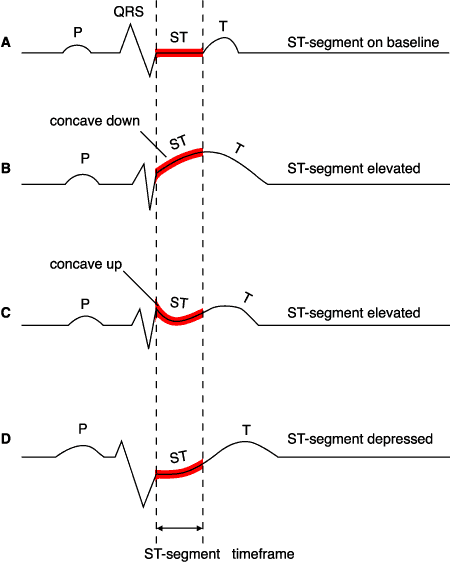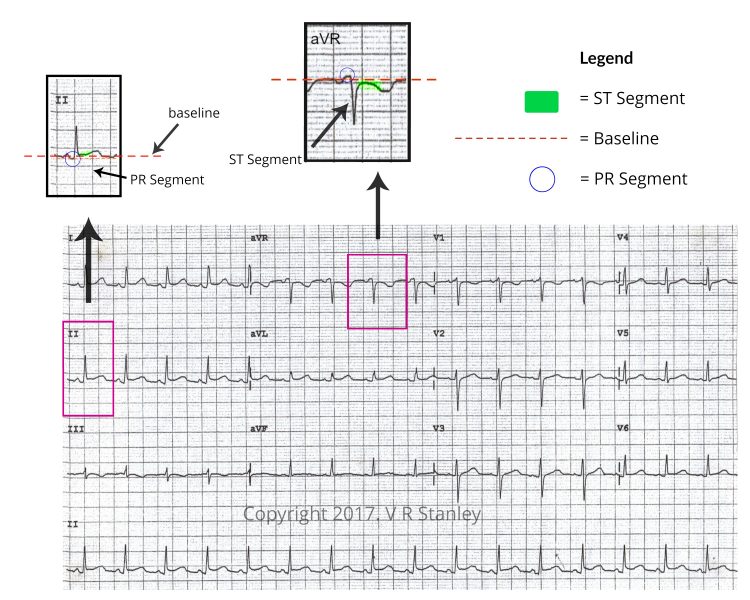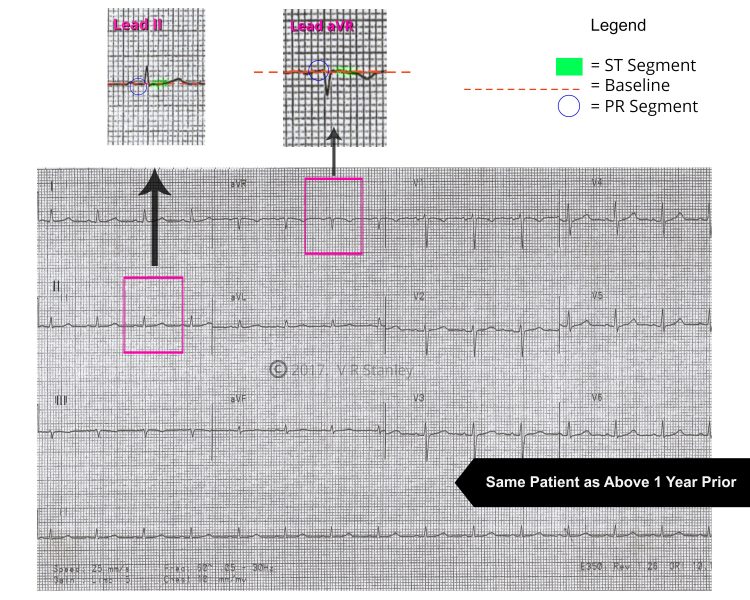This case study represents the first in a series of 3 discussing common differential diagnoses of ST-segment elevation. This case study will focus specifically on Pericarditis.
These 3 are common presentations which can mimic each other and which frequently present a dilemma to the provider.
- Pericarditis
- Benign Normal Variant
- Acute Anterior STEMI
Mini Pre Quiz
Q1 True / False: The ST Segment elevation shape characteristic of and Acute ST elevation MI is Concave Up (holds water).
Q2 The ST segment of a Normal 12-lead ECG can be:
A. Baseline
B. Elevated Concave Up
C. Either A or B
D. Neither A nor B
Q3 ST Segment elevation of Pericarditis is Concave ______ and present in nearly all of the 12-leads.
A. Up
B. Down
Scroll to bottom for answers.
Before we delve into the specifics of the 1st of these 3, let us briefly touch on the concept of ST-segment elevation.
CHARACTERISTICS OF THE ST-SEGMENT OF THE NORMAL ECG
The ST-segment of the 12-lead ECG is frequently the most time consuming portion of the analysis of the ECG. It is frequently the area of focus and disagreements among electrocardiographers since this area often reflects changes that will clinch the diagnosis of the acute MI or at least reflect subtle changes of suspect acute MI or myocardial ischemia or a benign normal variant. With this said and done, it is also true that the ST-segment often-times defies analysis and one is often forced to concede that “I am not sure of the diagnosis”. The important point to make here is that you must always look at the ST-segment (in all leads).
You must be aware that the ST-segment is ideally lying on the baseline to be NORMAL, but it is also true that a slight ST-segment elevation above the baseline (as a normal variant) is extremely common in the normal ECG (especially in Leads V1,V2,V3).
One of the keys to analyzing the ST-segment elevation meaning is in the curve shape (contour), described as concave up or concave down.
Here lies the diagnosis of suspect normal or suspect acute injury/infarction pattern.
“Figure A” demonstrates no elevation or depression of the ST-segment and is what we hope to see in a NORMAL” ECG in ALL leads.
“Figure B” demonstrates ST-segment elevation, i.e. the segment between time t1st and time t2st is elevated above the baseline. You should take note that the elevation of the t1st , t2st segment takes on a specific shape:
CONCAVE DOWN (sheds water)
This terminology, “concave down”, is useful and necessary for you to become familiar with since it is expected that your description of the 12-lead ECG will include such statements as “ST segment elevation present with concave down curvature”. As will be discovered later, the contour of the ST-segment will sometimes be the determining factor as to whether the ECG is a benign normal variant or one of an acute injury pattern with it’s life-threatening implications.
As a routine part of the ECG analysis, it is advised that you literally mark the ECG tracing with a colored pencil indicating t1st and t2st, then focus on this segment to determine its concavity.
You will notice that points t1st and t2st are generally unclear as to their location, but you simply must “guess” where these points should be and mark them accordingly. At best, points t1st and t2st are approximations and the CONCAVITY question will sometimes vary from interpreter to interpreter because of this variation in t1st and t2st.
“Figure C” demonstrates ST-segment elevation also but the ST-segment curvature is in a different direction from Figure B, i.e., it is “CONCAVE UP” (holds water).
It is interesting to note that “CONCAVE UP” is more often associated with a benign inconsequential normal variant of the ECG as will be seen in a later section.
“Figure D” demonstrates ST-depression below the baseline.
The purpose of presenting Figures A, B, C and D is to encourage the provider to program their mind to routinely mark and analyze the ST-segment of ALL leads of the 12-lead ECG. In particular, you must know that the ST-segment must lie on the baseline to be categorized as NORMAL. If this ST-segment baseline finding is violated, then you must analyze the curve further. In particular, if the ST (t1st, t2st) segment is elevated, we must make a judgment as to its concavity, i.e. “CONCAVE DOWN” or “CONCAVE UP“. This of course does not give the diagnosis but indeed is part of the puzzle and is absolutely vital to your final conclusion.
Clinical characteristics of acute pericarditis:
- Mid-pleuritic chest pain
- Pain worsens with recumbency
- Pain relieved by leaning forward
- Pericardial friction may be present
- Most are idiopathic or viral in origin
ECG Clues suggestive of Acute Pericarditis:
- Diffuse ST-segment elevation concave up (except Leads avR,V1)
- ST-segment depression Leads avR, V1
- Diffuse PR-segment depression (except Leads avR, V1)
- May exhibit PR-segment elevation Leads avR, V1
- May mimic Acute STEMI or Benign Normal Variant (Early Repolarization)
- Lack of reciprocal ST-segment changes
- R-wave progression usually normal
- Quotient ST/T = mm of ST segment elevation / mm height of T-wave > 0.25 mm in Lead V6
PERICARDITIS Example A
Same Patient’s ECG 1 Year Prior: Example B
Answer key: Q1. False (Concave Down/Sheds Water) | Q2. C. Either A or B | Q3. A. Up
Taken from the 50 Case & STEMI Mimic Course Combo Pack (19 hrs Cat I CME)




One Response